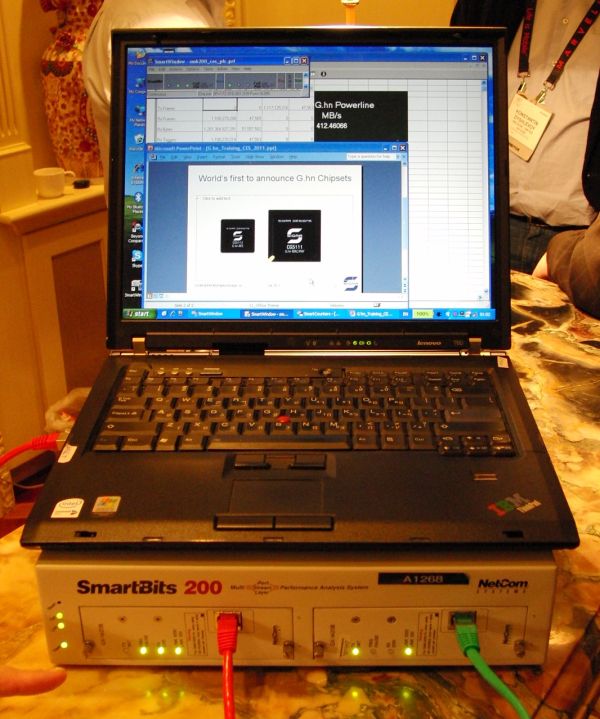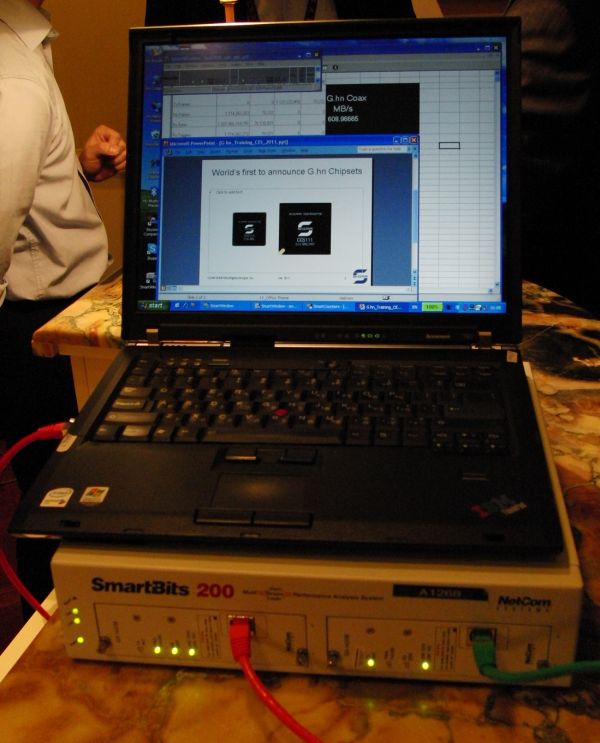G.hn Silicon Emerges from Vaporware Territory
by Ganesh T S on February 2, 2011 3:33 PM EST- Posted in
- Powerline Adapters
- G.hn
- HomePlug
At CES 2011, two companies demonstrated working silicon based on the G.hn standard. While Lantiq introduced the XWAY HNX100 series, Sigma Designs introduced their CG5110 chipset. I didn't have a chance to meet with Lantiq, and so, Sigma's CG5110 demonstration was the first time that I could really see G.hn in action.
Though both Lantiq and Sigma claim that their chipsets can be used over all three wired media (coax / phone lines / powerline), only Sigma seems to be backward compliant with HomePNA and HomePlug AV devices on the same network.
Sigma's Reuven Franco was kind enough to demonstrate the CG5110 in action over coax and also over a power strip. As can be seen in the photo of the setup I captured at the suite, the development board was hooked up to the Ethernet traffic generator. The actual application layer throughput was being measured in real time and updated on the spreadsheet.
Sigma's Demo Setup for the CG5110
Admittedly, the setup (power strip with no noise source and a plain coax cable) was not representative of real world conditions in general. However, it did end up giving us confidence in G.hn.
412 Mbps Over Powerline
608 Mbps Over Coax
Sigma also indicated that ClearPath Extreme (the next generation version of the ClearPath technology they had demonstrated on the CG2110) wasn't yet enabled on the CG5110. They were quite confident that the test results being demonstrated (as shown above) would be experienced by consumers in real world situations also.
Working silicon is a good first step for the G.hn supporters. However, a multitude of challenges still needs to be overcome. In particular, we are not aware of the cost of backward compatibility with HPAV and HPNA (for the CG5110). Other G.hn silicon vendors seem to have completely eschewed backward compatibility. With the existing HomePlug install base, this is still an area of concern for G.hn. Also, the extent of interoperability of the CG5110 will only be known if Sigma Designs volunteers its silicon for interoperability tests / products get to the consumers. It is also not clear if the performance of the CG5110 is limited by the silicon and protocol overheads associated with interoperability.
There is always a cost overhead associated with integrating support for different media types on the same chip. So, it looks like HomePlug devices will continue to be cheaper for powerline-only communication. In the service provider market, the extra cost is probably a minor factor compared to the installation cost savings, but it will definitely be a factor in the price sensitive retail market. In addition, service providers also want software maturity (carrier-grade). It remains to be seen how long that will take for the G.hn vendors, but getting working silicon out of the door is a good start.
As Sigma Designs stole the powerline show at CES 2011, what was Atheros in the HomePlug camp upto? We undertook a visit to their booth to find out.













18 Comments
View All Comments
wolrah - Thursday, February 3, 2011 - link
Sorry bud, but you're completely wrong. Look up the G.hn specs yourself. Depending on the region, on power lines it'll use anywhere from 1-200MHz. The power lines in your house are in general unshielded, making them effectively an enormous (though not particularly well optimized of course) antenna. The frequencies in use overlap with numerous radio bands, including a number of amateur bands, CB, commercial AM/FM, and commercial/government SW/MW/LW. I don't believe most public safety spectrum at least here in the US is that low down, but there probably is some. Particularly in amateur HF and SW/MW/LW being able to receive weak distant signals is important, so any interference on those bands is an annoyance to area users.I'm not sure why you bring up cordless phones. BPL and power-line networking don't come anywhere close to those, so there's no reason to think it passing the "teenage girl test" means anything at all (900MHz, 1.8GHz, 2.4GHz, and 5.8GHz are the four cordless phone frequencies seen in the US).
Again it will not interfere with any unlicensed radio services I'm aware of other than CB, but you're putting a fat signal in to a huge antenna right in the middle of a lot of licensed spectrum. The area of effect isn't huge, but as an amateur operator if you were my neighbor and you were broadcasting anything on the HF bands I'd offer to help fix it if possible, but if it couldn't be told to not operate in certain ranges it's turning off or you're getting an FCC complaint for broadcasting without a license and interfering with licensed users.
derkurt - Sunday, February 6, 2011 - link
I don't know exactly about the new G.hn devices, but a HomePlug AV2 500 Mbit/s device uses a spectrum from 2-68 Mhz. The standard employs these frequency filters (source: German wikipedia):* f ≤ 1,71 – AM Broadcast and below
* 1,71 < f < 1,8 – between AM and 160 meters band
* 1,8 ≤ f ≤ 2,0 – 160 meters amateur band
* 3,5 ≤ f ≤ 4,0 – 80 meters amateur band
* 5,33 ≤ f ≤ 5,407 – 5 MHz amateur band
* 7,0 ≤ f ≤ 7,3 – 40 meters amateur band
* 10,10 ≤ f ≤ 10,15 – 30 meters amateur band
* 14,0 ≤ f ≤ 14,35 – 20 meter amateur band
* 18,068 ≤ f ≤ 18,168 – 17 meter amateur band
* 21,0 ≤ f ≤ 21,45 – 15 meter amateur band
* 24,89 ≤ f ≤ 24,99 – 12 meter amateur band
* f >= 28,0 – 10 meter amateur band
In Germany, you are allowed to use Powerline devices as long as they don't interfere with other HF applications in your neighborhood. If they do, the Bundesnetzagentur (German FCC) can be called, which may request removal of the source of interference.
So far, I haven't heard of a single case where a radio amateur successfully requested removal of a HomePlug device. Keep in mind that the amateurs are likely to be the only ones which might be disturbed by PLC at 2-68 Mhz. In fact, as far as I know, the filters mentioned above cover all frequencies where a radio amateur is legally allowed to operate within the 2-68 Mhz range. Also, although PLC is admittedly turning the power wiring into an antenna, the signal strength remains small compared to other in-house HF applications, such as Wi-Fi.
In theory, PLC is a "dirty" solution and looks like it would be bound to cause problems. In reality, devices such as mobile phones, babyphones (which also use the power lines), and even WLAN are far more likely to annoy your neighbor.
davmat787 - Sunday, February 6, 2011 - link
Excellent post sir. Just the kind of complete and detailed post one would expect from a German. :)HoosierEngineer5 - Thursday, February 3, 2011 - link
Do any of these technologies replace the X-10 modules, or are they simply replicate Ethernet? It would be great if these could actually DO something other than pass data...andrewmc - Thursday, February 3, 2011 - link
Very nice. So when do I get my Homeplug Green PHY silicon.aahjnnot - Friday, February 4, 2011 - link
Powerline networking is relatively successful in Europe and Asia compared with North America because our housing stock is very different from yours. WiFi isn't a good solution in areas of very dense population, as interference from neighbouring networks can kill throughput. Traditional European housing stock with thick internal walls made of brick or stone kills WiFi, and the long, narrow shape of traditional British terraces mean that Wifi users can often have several neighouring networks that are closer than their own access point. And retro-fitting Ethernet into a property with traditionally plastered walls, stone floors and no wall voids needs either visible cabling or significant redecoration.By contrast, the traditional American wood-built detached property sitting in its own spacious yard is perfect for WiFi.
ragincajun84 - Wednesday, February 9, 2011 - link
Is this a paid article? It reads like an ad for Sigma and G.hn. It barely mentions the other silicon players yet raves about Sigma demos and slideware. Sigma has not brought a single powerline product to market and G.hn has been hyped for 5 years and still has no products on the market.ganeshts - Thursday, February 10, 2011 - link
I believe I have pointed out enough places where G.hn is yet to catch up or will have potential problems.I wrote the article after seeing Sigma's demonstrations both at their HQ in CA as well as their demo at CES. It really works in the demo situation / lab. Any new company will have teething trouble, trying to get into the market and convince customers. That doesn't mean the technology is not good. Yes, G.hn will have to present a really valid case to the concerned people to shift from HomePlug because HomePlug is very well established and mature.
At CES, after seeing what Atheros and Sigma had to offer, I believe Sigma has taken bigger strides and that is why 75% of the article is focused on them. (They have taken bigger strides because G.hn hasn't seen mature silicon yet). This article wasn't meant to be a coverage of the PLC industry as a whole.